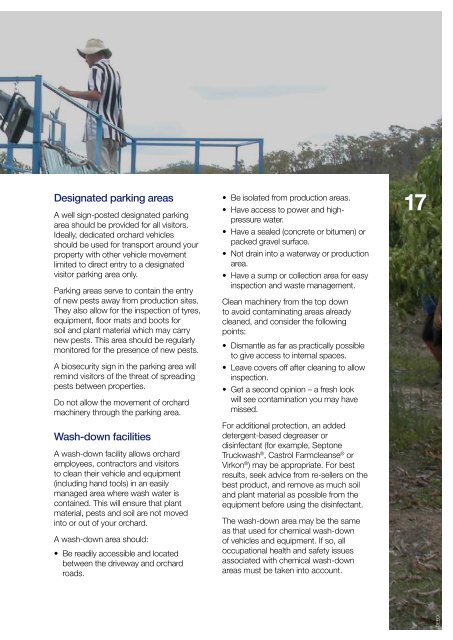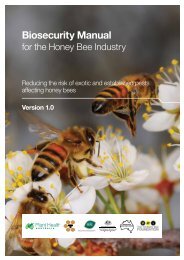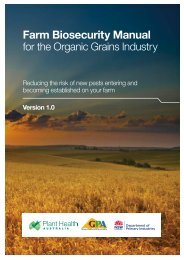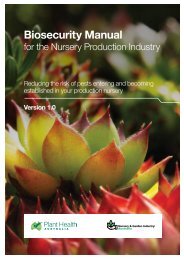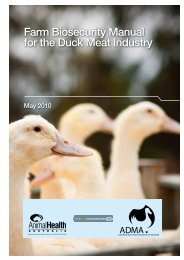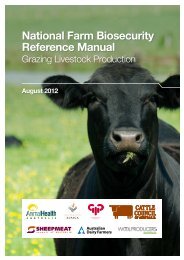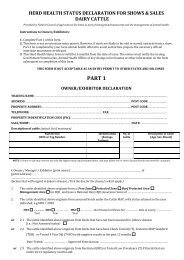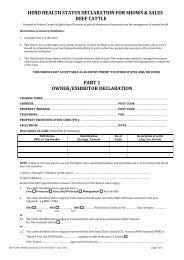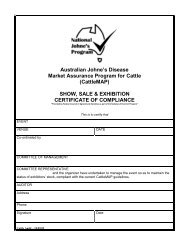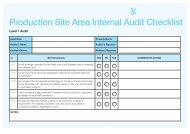Orchard Biosecurity Manual for the Mango Industry - Farm Biosecurity
Orchard Biosecurity Manual for the Mango Industry - Farm Biosecurity
Orchard Biosecurity Manual for the Mango Industry - Farm Biosecurity
Create successful ePaper yourself
Turn your PDF publications into a flip-book with our unique Google optimized e-Paper software.
Designated parking areas<br />
A well sign-posted designated parking<br />
area should be provided <strong>for</strong> all visitors.<br />
Ideally, dedicated orchard vehicles<br />
should be used <strong>for</strong> transport around your<br />
property with o<strong>the</strong>r vehicle movement<br />
limited to direct entry to a designated<br />
visitor parking area only.<br />
Parking areas serve to contain <strong>the</strong> entry<br />
of new pests away from production sites.<br />
They also allow <strong>for</strong> <strong>the</strong> inspection of tyres,<br />
equipment, floor mats and boots <strong>for</strong><br />
soil and plant material which may carry<br />
new pests. This area should be regularly<br />
monitored <strong>for</strong> <strong>the</strong> presence of new pests.<br />
A biosecurity sign in <strong>the</strong> parking area will<br />
remind visitors of <strong>the</strong> threat of spreading<br />
pests between properties.<br />
Do not allow <strong>the</strong> movement of orchard<br />
machinery through <strong>the</strong> parking area.<br />
Wash-down facilities<br />
A wash-down facility allows orchard<br />
employees, contractors and visitors<br />
to clean <strong>the</strong>ir vehicle and equipment<br />
(including hand tools) in an easily<br />
managed area where wash water is<br />
contained. This will ensure that plant<br />
material, pests and soil are not moved<br />
into or out of your orchard.<br />
A wash-down area should:<br />
• Be readily accessible and located<br />
between <strong>the</strong> driveway and orchard<br />
roads.<br />
• Be isolated from production areas.<br />
• Have access to power and highpressure<br />
water.<br />
• Have a sealed (concrete or bitumen) or<br />
packed gravel surface.<br />
• Not drain into a waterway or production<br />
area.<br />
• Have a sump or collection area <strong>for</strong> easy<br />
inspection and waste management.<br />
Clean machinery from <strong>the</strong> top down<br />
to avoid contaminating areas already<br />
cleaned, and consider <strong>the</strong> following<br />
points:<br />
• Dismantle as far as practically possible<br />
to give access to internal spaces.<br />
• Leave covers off after cleaning to allow<br />
inspection.<br />
• Get a second opinion – a fresh look<br />
will see contamination you may have<br />
missed.<br />
For additional protection, an added<br />
detergent-based degreaser or<br />
disinfectant (<strong>for</strong> example, Septone<br />
Truckwash ® , Castrol <strong>Farm</strong>cleanse ® or<br />
Virkon ® ) may be appropriate. For best<br />
results, seek advice from re-sellers on <strong>the</strong><br />
best product, and remove as much soil<br />
and plant material as possible from <strong>the</strong><br />
equipment be<strong>for</strong>e using <strong>the</strong> disinfectant.<br />
The wash-down area may be <strong>the</strong> same<br />
as that used <strong>for</strong> chemical wash-down<br />
of vehicles and equipment. If so, all<br />
occupational health and safety issues<br />
associated with chemical wash-down<br />
areas must be taken into account.<br />
17<br />
DEEDI


